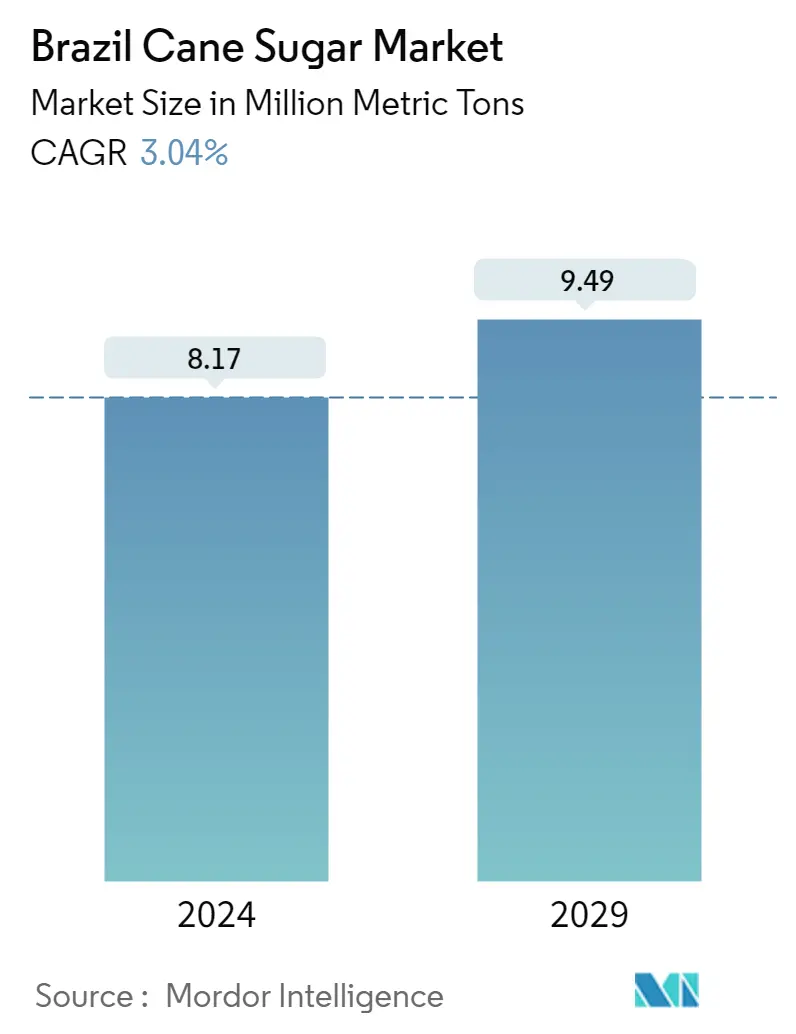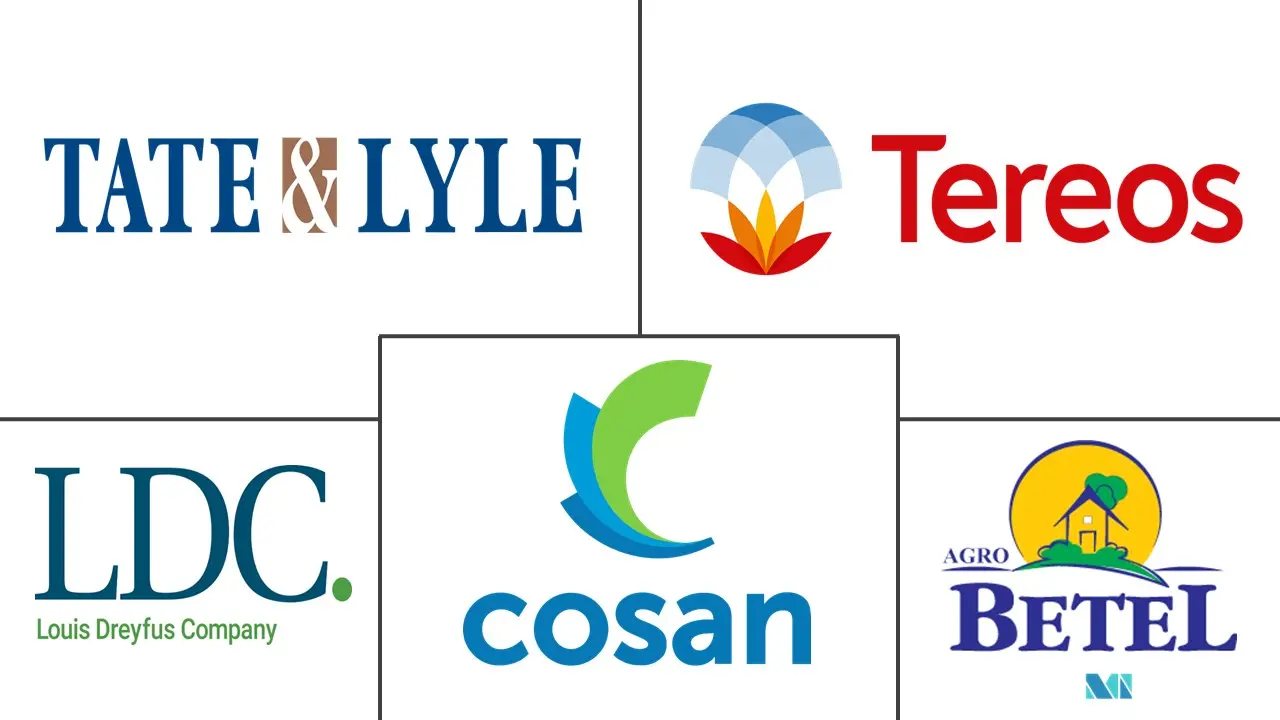Market Size of Brazil Cane Sugar Industry

| Study Period | 2019 - 2029 |
| Base Year For Estimation | 2023 |
| Forecast Data Period | 2024 - 2029 |
| Historical Data Period | 2019 - 2022 |
| CAGR (2024 - 2029) | 3.04 % |
| Market Concentration | Low |
Major Players
*Disclaimer: Major Players sorted in no particular order |
Brazil Cane Sugar Market Analysis
The Brazil Cane Sugar Market size is estimated at 8.17 Million metric tons in 2024, and is expected to reach 9.49 Million metric tons by 2029, growing at a CAGR of 3.04% during the forecast period (2024-2029).
- The sugarcane industry in Brazil is playing a leading role in the global market. Approximately 70% of Brazil's sugar production is exported, which accounts for 49% of global exports. More than 100 countries worldwide import Brazilian sweetener, which aids in the fight against malnutrition and provides a significant natural and easily available source of energy for consumers. According to UNICA (Portuguese: Uniào da Indústria de Cana-de-Açúcar), in 2022, the Brazilian Sugarcane Industry Association, the country's social, political, and economic history is all deeply rooted in the heritage of sugar.
- Brazil is one of the world's most popular sugarcane producers and exports and imports sugar. Brazil contributes to about 23% of the world's production. The country has flexible production mills which can change their production level while processing. Attributed to the abundance of sugarcane and the properties of sugarcane being superior to beet sugar and offering better flavor and caramelization is supporting market demand. Further, Brazil is a part of the Global Alliance for Sugar Trade Reform and Liberalization, an organization that works to facilitate the ability of individuals to trade sugar internationally.
- Manufacturers focus on new investments leading to technological innovations, thus supporting ethanol production as a clean alternative to 'fossil fuels.' Furthermore, the opportunities for organic and fair-trade cane sugar are also rising in the country. Consumers are increasingly interested in consuming healthy and natural products, paving the way for interesting opportunities for organic and ethically sourced products and their production by manufacturers.
Brazil Cane Sugar Industry Segmentation
Sugar derived from sugar cane is known as cane sugar. Cane sugar comes in many forms, including raw, refined, and unrefined. It can be filtered through charcoal to obtain pure white color.
The Brazil cane sugar market is segmented, based on form, into crystallized sugar and liquid sugar. Based on application, the market is segmented into food and beverage, pharmaceutical, industrial, and other applications.
The report offers market size and forecasts in value (USD million) for all the above segments.
| By Type | |
| Crystallized Sugar | |
| Liquid Sugar |
| By Application | |
| Food and Beverage | |
| Pharmaceuticals | |
| Industrial | |
| Other Applications |
Brazil Cane Sugar Market Size Summary
The Brazil cane sugar market is a pivotal segment of the global sugar industry, with Brazil being a leading producer and exporter. The country's sugarcane industry is deeply intertwined with its social, political, and economic fabric, contributing significantly to the global supply. Brazil's sugar production is characterized by its flexibility and adaptability, supported by advanced technological innovations and a robust infrastructure. The market benefits from Brazil's membership in international trade organizations, which facilitate sugar trade liberalization. The demand for Brazilian cane sugar is bolstered by its superior quality compared to beet sugar, offering better flavor and caramelization. The market is also witnessing a growing interest in organic and fair-trade products, aligning with global consumer trends towards healthier and ethically sourced options.
The Brazilian cane sugar market is characterized by a diverse range of applications across various industries, particularly in food and beverages, pharmaceuticals, and industrial sectors. The beverage industry, in particular, is recovering and expanding, driving increased demand for cane sugar. The market is fragmented, with numerous local and international players vying for market share. Key players such as Tate & Lyle, Tereos SA, and Louis Dreyfus Company are actively investing in technological advancements and strategic partnerships to enhance their market presence. The market's growth is further supported by Brazil's favorable economic conditions, including a weak currency that boosts exports and profitable sugarcane-based ethanol production. The ongoing technological advancements and strategic investments are expected to sustain the market's growth trajectory in the coming years.
Brazil Cane Sugar Market Size - Table of Contents
-
1. MARKET DYNAMICS
-
1.1 Market Drivers
-
1.2 Market Restraints
-
1.3 Porter's Five Forces Analysis
-
1.3.1 Threat of New Entrants
-
1.3.2 Bargaining Power of Buyers/Consumers
-
1.3.3 Bargaining Power of Suppliers
-
1.3.4 Threat of Substitute Products
-
1.3.5 Intensity of Competitive Rivalry
-
-
-
2. MARKET SEGMENTATION
-
2.1 By Type
-
2.1.1 Crystallized Sugar
-
2.1.2 Liquid Sugar
-
-
2.2 By Application
-
2.2.1 Food and Beverage
-
2.2.2 Pharmaceuticals
-
2.2.3 Industrial
-
2.2.4 Other Applications
-
-
Brazil Cane Sugar Market Size FAQs
How big is the Brazil Cane Sugar Market?
The Brazil Cane Sugar Market size is expected to reach 8.17 million metric tons in 2024 and grow at a CAGR of 3.04% to reach 9.49 million metric tons by 2029.
What is the current Brazil Cane Sugar Market size?
In 2024, the Brazil Cane Sugar Market size is expected to reach 8.17 million metric tons.

